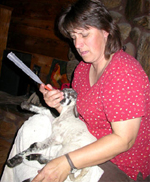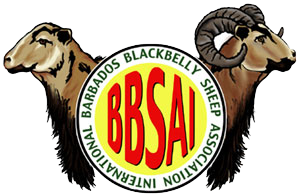
One of the most useful items to have around the barn is a stomach tube, also called a feeding tube, lamb reviver or saver, or weak kid syringe. Tube feeding is the simplest, safest, and quickest way to feed any lamb or kid that can hold its head up and sit up under its own power. Albeit, it’s somewhat intimidating the first time you tube feed a lamb or kid. I know how I felt; I was convinced I was going to put milk into the lamb’s lungs and drown it. Now, I wouldn’t hesitate to tube feed a lamb or kid that needs it. While it’s possible to insert the tube into the animal’s windpipe, it’s not very likely. The lamb will let you know if you’re doing it right.
Measure the tube on the outside of the lamb so you can see how far to insert it. Lay the tube along the lamb from the tip of its nose, along the neck and side, so the tip lies at the last rib. Mark the tube at the nose and this will show the length to insert.
Here’s how you do it: Find yourself a comfortable place to sit; a bale of hay or straw will do. Hold the lamb or kid on your lap. Another technique is to hold the lamb between your legs. Support the lamb’s head with your hand and extend its neck slightly to give the tube a more direct path to the stomach. Lubricate the tube in warm water or milk before inserting it. If you encounter a bump when inserting the tube, back up and try again. If cool air is felt coming out of the empty tube after it has been inserted, remove and try again. Reposition the lamb if necessary.
The lamb should show no signs of discomfort as the tube slips down the esophagus and reaches its stomach. It will chew on the tube, but should lie quiet when the tube is in place. If the lamb coughs, rolls its eyes, struggles and calls out as you are inserting the tube, then withdraw it immediately; you’ve probably put it down the windpipe by mistake. The length of the tube should indicate whether or not the stomach has been reached. Most tubes are of the length such that there will be 2 to 3 inches sticking out of the lamb’s mouth once the tube is fully inserted.
You should have a full syringe attached to the tube. Empty it to a slow count of 20. The plunger is not needed if the syringe is being used in a vertical, upright position. To prevent milk from getting into the lamb’s lungs, you should pinch the end of the tube when withdrawing it. Don’t worry if the lamb coughs a little after you remove the tube; a drop of milk may have entered its windpipe upon removal of the tube. Lambs and kids should receive 20 ml (cc) of colostrum per pound of body weight. Feedings should be given four hours apart. The smaller the lamb, the more frequent the feedings should be to avoid overloading the lamb. Most lambs are underfed. According to the Pipestone (Minnesota) Veterinary Clinic, a large lamb requires 50 oz. of colostrum the first 24 hours. Extra large lambs require even more.
You should only tube feed lambs that can swallow. Never tube a lamb that is unconscious. A semi- or unconscious lamb cannot swallow and will not react if the tube is inserted incorrectly. Lambs that are so weak and cold that they cannot lift their heads should receive an intra-peritoneal (in the abdomen) injection of glucose.
It is better to tube feed a chilled lamb than to feed it on a bottle as it is less likely to choke this way. It is also better to tube feed a lamb that you plan to graft onto another ewe as a bottle-fed lamb is less likely to nurse a ewe than a lamb that was tube fed. Tube feeding also helps to prevent lambs from bonding with humans.
I’ve found tube feeding to be a great labor saver. We’ve all struggled with small or orphan lambs, trying to get them to nurse from a bottle, only to throw our hands up in total frustration. With tubing, you can be assured the lamb is getting the colostrum that it needs.
A number of commercial tubing devices are available. The simplest is a 60 cc (2 oz.) syringe and catheter. Tubing should be 14 to 18 inches long (long enough to extend from the lamb’s last rib to its mouth plus approximately another foot, 18 gauge, and preferably rubber, like that used for surgical procedures. If you’re a little unsure about tube feeding a lamb, don’t hesitate to contact an experienced shepherd or veterinarian for assistance.
Reprinted with permission by Susan Schoenian
Editor, Maryland Sheep and Goat Producers
